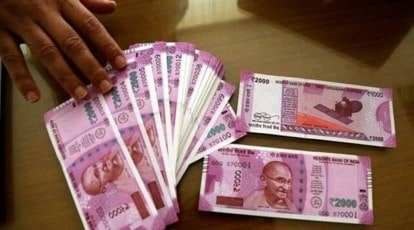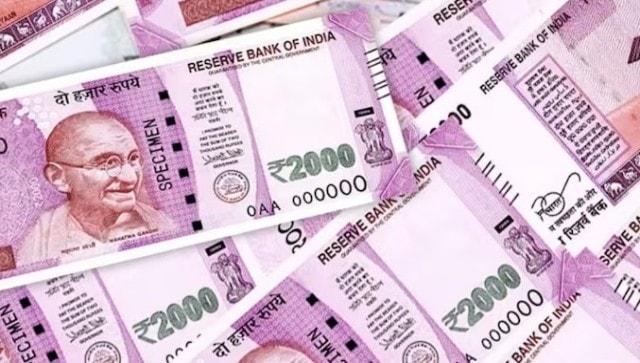RBI’s Bold Move: Over 97% of ₹2,000 Notes Returned, Reshaping India’s Financial Landscape

RBI’s Bold Move: Over 97% of ₹2,000 Notes Returned, Reshaping India’s Financial Landscape
In a landmark financial development, the Reserve Bank of India (RBI) recently announced that over 97% of the ₹2,000 banknotes in circulation as of May 19, 2023, have been successfully returned. This revelation came on the same day the RBI made a significant decision to withdraw ₹2,000 notes from circulation. The impact of this move on India’s economic landscape cannot be overstated. From the total value of ₹2,000 banknotes amounting to ₹3.56 lakh crore on May 19, 2023, it has now plummeted to ₹0.10 lakh crore as of October 31. This dramatic shift is poised to shape the future of India’s economy and has far-reaching implications for its citizens.
The ₹2,000 banknote, introduced in 2016 as a part of the government’s demonetization effort, was aimed at curbing the circulation of black money and encouraging digital transactions. However, the recent move by the RBI signals a shift in policy, raising questions about the effectiveness of the ₹2,000 note in achieving its intended goals.
The Journey of the ₹2,000 Banknote
To comprehend the significance of this recent development, let’s take a closer look at the journey of the ₹2,000 banknote and its role in the Indian economy.
The ₹2,000 note was introduced in November 2016, during the demonetization exercise spearheaded by Prime Minister Narendra Modi. The demonetization of ₹500 and ₹1,000 notes was intended to crack down on black money, counterfeit currency, and corruption. The new ₹2,000 note was introduced as a quick replacement to ensure that there was sufficient liquidity in the market.
At that time, it was believed that the higher denomination note would help facilitate larger transactions and bring about a digital revolution by promoting electronic payments. The government was optimistic that the introduction of new currency and the simultaneous promotion of digital payment methods would curb black money and corruption.

The Rapid Withdrawal
Fast forward to May 19, 2023, when the RBI made the startling announcement of withdrawing the ₹2,000 notes from circulation. The decision was a part of a broader initiative to reevaluate the role of high-denomination currency in the Indian economy. The data available up to that point showed that a substantial portion of these notes had been returned to the banking system, indicating that they were primarily being used for legitimate transactions.
The total value of ₹2,000 banknotes in circulation on that day was ₹3.56 lakh crore, a substantial amount that had been in use for over six years. The central bank, in its announcement, highlighted its concern about the high-value notes being used for hoarding, tax evasion, and unaccounted wealth. By withdrawing these notes, the RBI sought to limit the availability of such high-denomination currency and encourage a shift towards digital transactions.
A Major Paradigm Shift
The move to withdraw the ₹2,000 notes signifies a paradigm shift in the Indian government’s approach to currency and finance. It is evident that the objectives set during demonetization were not entirely met, prompting a reevaluation of the ₹2,000 note’s role in the economy.
The decision to phase out the ₹2,000 notes reflects the government’s acknowledgment of the currency’s limitations in curbing black money and corruption. Instead, the focus is shifting towards promoting digital transactions and financial inclusion.
A Closer Look at the Numbers
The statistics surrounding the withdrawal of ₹2,000 notes are both striking and revealing. The fact that over 97% of these notes have been returned to the banking system speaks to a change in their usage pattern. By October 31, 2023, the total value of ₹2,000 notes in circulation had fallen drastically to ₹0.10 lakh crore, indicating a massive shift away from these high-denomination notes in just a few months.
This substantial withdrawal of ₹2,000 notes from circulation also signifies a decline in their use for illegal activities and tax evasion. It suggests that a significant portion of these notes had re-entered the formal financial system.

The Impact on Black Money and Corruption
While the initial introduction of the ₹2,000 note aimed to tackle black money and corruption, the withdrawal of these notes is likely to have a more pronounced impact. With the vast majority of these notes back in the system, it is evident that they had found their way into the formal economy.
The reduced availability of high-denomination notes could make it more challenging for individuals engaged in illegal activities to hoard and transact with large sums of cash. This, in turn, may lead to greater transparency and scrutiny in financial transactions, ultimately working to combat tax evasion and money laundering.
The Shift Towards Digital Payments
Another significant aspect of this development is the government’s renewed focus on promoting digital payments. The withdrawal of the ₹2,000 notes serves as a clear signal that the authorities are keen on encouraging electronic transactions, which leave a digital trail and contribute to increased transparency.
In the wake of this decision, it is expected that more Indians will embrace digital payment methods, such as mobile wallets, UPI (Unified Payments Interface), and digital banking. The government and financial institutions have been actively pushing for digital adoption, and the withdrawal of the ₹2,000 notes can be seen as a catalyst for this transition.
Implications for Financial Inclusion
One of the significant challenges in India’s financial landscape has been ensuring financial inclusion for all citizens. Many individuals, especially in rural areas, still rely heavily on cash for their daily transactions. The move to withdraw ₹2,000 notes may pose a challenge for these individuals, as they may face difficulties in accessing sufficient cash for their needs.
However, this challenge can also serve as an opportunity to promote the use of digital financial services among the unbanked and underbanked populations. Financial institutions can work towards simplifying and expanding their digital offerings, making it easier for people to access and use digital financial services, even in remote areas.
Ensuring Smooth Transition
It is essential for the government and the RBI to ensure a smooth transition from high-denomination cash to digital payments. This means not only providing the necessary infrastructure but also educating citizens about the benefits of digital finance and how to use these services effectively.
Efforts should be made to address the concerns of those who may face difficulties due to the withdrawal of ₹2,000 notes, and suitable alternatives should be put in place to ensure that financial services remain accessible to all.
The Future of Currency in India
The withdrawal of the ₹2,000 notes signals a broader shift in the way India views and uses currency. It is clear that the government is committed to promoting transparency, reducing black money, and encouraging digital transactions.
The move raises the question of whether this is just the beginning of a larger transformation in India’s currency system. While the ₹2,000 note has been withdrawn, it’s essential to consider whether other denominations might also come under scrutiny in the future.

Conclusion
The withdrawal of over 97% of ₹2,000 banknotes from circulation is a significant and unprecedented move by the Reserve Bank of India. It not only reflects a shift in the government’s approach to currency but also emphasizes the importance of promoting transparency and digital transactions in the Indian economy.
This change comes on the heels of a six-year experiment with the ₹2,000 note, which was introduced with the aim of curbing black money and promoting digital payments. While the success of these initial goals may be debated, the withdrawal of the ₹2,000 notes is a clear indicator of the government’s commitment to reshaping India’s financial landscape.
The impact of this decision on black money, corruption, digital payments, and financial inclusion remains to be seen. However, it undeniably marks a significant turning point in India’s financial history and may well shape the country’s economic trajectory for years to come. As India moves forward, it will be crucial to ensure that this transition is as smooth and inclusive as possible, with a keen eye on the ever-evolving landscape of currency and finance.




